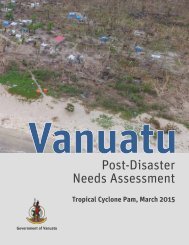Fiji
yqgk302EGjo
yqgk302EGjo
You also want an ePaper? Increase the reach of your titles
YUMPU automatically turns print PDFs into web optimized ePapers that Google loves.
Damage to South Ridge communications tower on Viti Levu<br />
Source: Chris Wensley/ADB<br />
wireless networks cover approximately 95 percent of the population. Due to improved network coverage and competitive<br />
pricing, mobile phone subscriptions have increased by 7.9 percent annually from 2007 to 2015, with the total number of<br />
subscribers reaching 965,950 by the end of the period. Landline usage has fallen in recent years as mobile phone usage<br />
has grown, and fixed telephone subscriptions per 100 people fell from 14.6 in 2007 to 8.4 in 2014. Household penetration<br />
of Internet broadband increased from 7.1 percent in 2007 to 30.7 percent in 2014, while the percent of individuals with<br />
Internet access rose from 10.9 percent to 41.8 percent over the same period, with 36.7 percent of households owning<br />
computers. Household expenditures on communications have risen steadily over the last decade. The proportion of<br />
household nonfood expenditure on communications rose from 4.3 percent in 2002/2003 to 5.4 percent in 2008/2009,<br />
reflecting the rapid rise in the number of mobile subscribers and the increasing importance of communications in the lives<br />
of all <strong>Fiji</strong>ans. 109<br />
<strong>Fiji</strong>’s communications sector comprises a mix of public and private corporations, including: Telecom <strong>Fiji</strong> Limited (TFL),<br />
which is the sole provider of local and long-distance fixed-line telephone services; <strong>Fiji</strong> International Telecommunications;<br />
two mobile service operators, Vodafone and Digicel (which also offer mobile Internet services); two broadband service<br />
providers (Connect and Unwired); and a number of information and communication technology (ICT) support services.<br />
Private broadcasters include Communications <strong>Fiji</strong> Ltd., MaiTV and <strong>Fiji</strong> TV, with <strong>Fiji</strong> Broadcasting Corporation Ltd., the<br />
sole state-owned broadcaster. Government direct investment in the sector includes the establishment of 26 Government<br />
Community Telecentres that enable remote communities to access educational resources, information, public services,<br />
and business products and services on the Internet. Post <strong>Fiji</strong> Ltd., a state-owned enterprise, provides national letter and<br />
parcel services, and several national and international companies provide courier services.<br />
The domestic ICT infrastructure includes extensive copper and fibre-optic cable networks that cover most urban and rural<br />
areas in Viti Levu and Vanua Levu, although some places remain without telecommunications coverage. Both TFL and<br />
FEA have invested substantially in underground fibre-optic cable networks. Mobile network operators rely largely on radio<br />
communications between cell towers and base stations, and approximately 1,399 base stations are located throughout<br />
<strong>Fiji</strong>. Table 64 shows the pre-disaster asset valuation for the sector.<br />
109<br />
Data are from the <strong>Fiji</strong> Bureau of Statistics.<br />
92 Tropical Cyclone Winston, February 20, 2016



